#Oculus Rift Extension Cable
Explore tagged Tumblr posts
Text
Price: [price_with_discount] (as of [price_update_date] - Details) [ad_1] Product Description CableCreation Active USB 2.0 Extension Cable offers an easy and inexpensive way to extend your USB connection to the computer or Mac by 16 Feet. 16.4 FT long with Signal Booster let you connect to the printer more stable and reliable than wireless connection. Frequently Asked Questions: 1. Does this USB repeater cable require drivers? -No, it's driver-free for any operating system including Windows, macOS, Mac OS X, Linux, Chrome OS, etc. 2. Is this compatible with any USB 2.0 devices ? -Yes, it works fine with USB 2.0 devices, such as for Oculus Rift Sensor, CCTV, DVR, gamepad, printer, scanner, keyboard,camera, mouse, etc. 3. Can I use it to extend the USB-C cable? -Yes, the data transmission can reach 480Mbps, but because of the voltage issue, if you want to charge your cellphone or computer, we recommend our product B08RMLWVL6 and B08RN2VMCC. 4. Can I connect two cables or more to use? -No, we don't suggest to connect two cables or more for extension as the power will not enough, and it will not work. Interface Protection Protecting the USB sockets on your devices from repeatedly plugging and unplugging. Extend USB port for laptop or desktop No need to squeeze yourself to connect USB disk or other USB peripherals anymore. NXP signal booster 16 FT Long, no signal attenuation. Add to Cart Add to Cart
Add to Cart Add to Cart Add to Cart Customer Reviews 4.2 out of 5 stars 590 4.4 out of 5 stars 7,002 4.2 out of 5 stars 590 4.2 out of 5 stars 590 4.2 out of 5 stars 20 4.2 out of 5 stars 2,286 Price ₹2,499.00₹2,499.00 ₹2,799.00₹2,799.00 ₹4,699.00₹4,699.00 ₹4,699.00₹4,699.00 — no data ₹3,569.00₹3,569.00 Port USB A USB A USB A USB A, USB C USB C USB A, USB C Date rate 480Mbps 5 Gbps 10 Gbps 10 Gbps 10 Gbps 5 Gbps Cable length 5 Meters 5 Meters 5 Meters 5 Meters 5 Meters 5 Meters Compatible VR devices For Oculus Rift Sensor For Oculus Quest For Oculus Quest For Oculus Quest For Oculus Quest For Oculus Quest no data For Oculus Quest 2 For Oculus Quest 2 For Oculus Quest 2 For Oculus Quest 2 For Oculus Quest 2 no data For Oculus Rift Sensor For Oculus Rift Sensor For Oculus Rift Sensor no data no data Optimal Signal Clarity: The USB 2.0 active extension cable features a signal booster design with a built-in NXP chip, gold-plated connectors and an inner braided shield. Excellent link performance is ideally avoiding attenuation for extra long-distance data transfer for a smoother, clearer experience than an ordinary USB cord.
Broad Compatibility: Compatible with USB Extender is also excellent for CCTV camera, hard drive, mouse, gamepad, Xbox, Printer and most popular USB devices. Plug and play, no driver required. Super Speed and Stable transmission: USB 2.0 data transfer rate up to 5Gbps, allowing you to transfer HD movies or files in seconds. Note: ONLY work with USB 2.0 peripherals, so please connect the USB 3.0 port at both ends to ensure optimal performance. Extend & Protect USB Port: With this USB A extension cord, there is no need to squeeze yourself to the back of the TV or desktop to connect a USB disk or other USB peripherals. Protect the USB sockets on your devices from repeatedly plugging and unplugging. The USB cable extender is durable and flexible, and the 16.4 ft long length gives you freedom and movement. What You Get: 1 * USB Extension Cable 16.4 FT. CableCreation provides the item with 24 Months warranty, lifetime technical support, and friendly customer service. [ad_2]
0 notes
Text
Why Extension Cable is Needed for a Oculus Rift?
https://www.alxum.com/blogs/news/why-extension-cable-is-needed-for-a-oculus-rift
News
Why Extension Cable is Needed for a Oculus Rift?
POSTED BY KENNY LEE · MARCH 17, 2021
I bet you a VR fans if you notice this article, you may take your VR to anywhere for fun. But if you go outside that you was limited by wireless oculus. And do you often feel upset if your wireless oculus is not stable?
That's Why Extension Cable is Needed for a Oculus Rift
VR is bandwidth hungry and the longer the cable, the more likely you are to run into problems. Long active extension cable always allows you huge flexibility in setup without sacrificing performance. It's really a importance for VR fans to find a best usb 3.0 extension cable for oculus rift.
How to Extend your Oculus Rift Cable
Plug the male cable end from the sensor into the female end on the extension cable.
Plug the extension into your PC.
5V/2A power adapter is needed for high-power devices to get additional power.
Your sensor will have an extra 16 feet or 32 feet to work with Alxum Oculus Rift Cables, which in most cases should be more than enough when setting up a room-scale Rift experience.
Wait, it's not only a oculus rift cable, but also good for extend other usb devices, such us Webcam, USB Flash Drive, Mouse, Keyboard, Printer, Scanner, Camera, Hard Drive, Gamepad, Xbox 360 Kinect, Speaker, WiFi Receiver, USB Hubs, etc. Alxum 10M extension cable easily extends your webcam, printer, oculus vr devices with Two Signal Boosters that ensure no signal attenuation for 10 meters/32ft length.
Video on How to Extend Your Webcam & USB Devices (Alxum 10M Extension Cable)
Alxum offers various extension cables at 16ft and 36ft in length. We recomend that you choose oculus rift cable based on your room. No matter you need for Oculus Link, Rift, Quest, 5M and 10M is long enough to transfer data between your computer and devices over long distances. (Please pair with usb c adapter for quest.)
Alxum New Oculus Rift Extension Cable 10M/32FT
WEme USB 3.0 Extension Cable for Oculus Rift VR (5M/16FT)
WEme USB 3.0 Extension Cable for Oculus Rift 10M/32FT
WEme USB C Extension Cable for Oculus VR 10M/32FT
WEme USB C Extension Cable for Oculus VR 5M/16.4FT
You don't want to miss out because it's cost-friendly, and it's been tested to confirm it works with Rift sensors. $17 for 5M, $29 for 10M. I must choose the 10M for biggest fun with my oculus. Extend to 5M-10M, which is no doubt more than enough to hit the back and corners of your VR room. If you want a best extension cables for oculus rift, I recommend
Alxum 10M Oculus Rift Extension Cable
Alxum friend can't wait to play Oculus Link with Alxum new 10M Oculus Rift Extension Cable, he tried and videoed for how oculus rift cable works. If you have any question you could join and comment.
Video Share:
AMAZING Oculus Link works GREAT with this *10M LONG* Oculus Rift Extension Cable from Alxum
1 note
·
View note
Text
Top 10 Best usb 3.0 extension cable for oculus rift [2022]
Top 10 Best usb 3.0 extension cable for oculus rift [2022]
1. CableCreation Active USB Extension Cable (Long 16.4 FT), USB 3.0 Extender Male to Female Cord with Signal Booster Compatible Oculus Rift Sensor, Oculus Quest/Quest 2 VR, Xbox one, etc. 5 Meters Buy On Amazon 【Connectivity & Compatibility】USB 3.0 active extension cable features signal booster design with built-in NXP chip perfectly avoid attenuation for long-distance data transfer, great for…
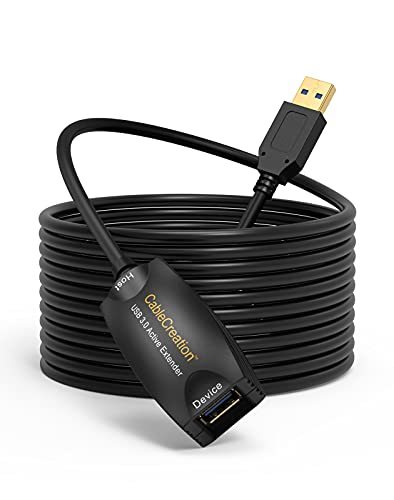
View On WordPress
0 notes
Text
ULTX vs. Virtual Reality
I’m really flustered and upset about VR right now. It’s kind of been like this for a few weeks. It started when my mom got hired at a VR arcade. It was more of a surprise that she got hired, given her lack of technical knowledge. I’ve basically been teaching her by proxy of learning all my own.
This has been persistent as I’ve watched countless videos from reviews to comedy and anything in-between. I’ve read reviews and comparisons of all the hardware across the board, I’ve looked at costs, pros, cons, compatibility, limitations, solutions and I’m about ready to pull my hair out.
VR has been a bit iffy since it officially kicked off in 2016 when HTC Vive and Oculus Rift released. For a minute, people were absolutely locked in on the Vive because it was doing something different from the Rift - it had interactive controls in a three-dimensional space thanks to its tracking and wands. The Rift, up until the Touch controllers, had an Xbox One controller bundled in.
The Vive had a prohibitive issue: price. At $800, that was no mere drop in the bucket, and it relies on you having a competent gaming PC. Assuming you didn’t, you were looking at a possible $1500+ purchase for a rig and the headset. The Rift, even when it finally added the Touch controllers, is still rather expensive, and has its own marketplace fragmenting the PC space, in a time where the last thing you want is segmentation in an emerging market.
Then PSVR hit, and again, another segment, but this was probably the most interesting one - $800 was the cheapest if you had no VR headset or PS4. And the marketshare Sony holds with the PS4 was likely way higher than the number of people with VR-ready gaming PCs.
At the end of 2017, of course, Microsoft put their hand in the ring with Windows Mixed Reality. The aim there was to offer another, cheaper option, at least until Oculus took advantage of their new Facebook moneys to slash the Rift and Touch to $400, directly competing against the MR headsets that were launching without controllers bundled at the same price. That said, Microsoft didn’t sit around, and have even baked in SteamVR support to ensure there’s no issues with the lack of content on their storefront (called the Blackberry approach).
So now, it’s nearing the summer season, and the tax refund session is kicking off. People are going to have a lot of money thrown their way, myself included, and we’re all going to be confronted with choices.
I’ve been committed enough to make a small list of pros and cons for the current crop of PC headsets.
* * *
Windows MR
Pros
* Sub-$300 price, cheaper than even PSVR
* Inside-out tracking means no towers of sensors to set up
* Two wires go in, and Windows basically handles the rest
* SteamVR support from the get-go (thanks Valve lu bby)
Cons
* Windows 10 required, updates and NSA backdoors intact
* Tracking solution has limited sight so controllers will snap back in sight in a distracting way
* Controllers are cheapo, apparently
* LCD display instead of OLED means a delay in response time
* * *
Oculus Rift
Pros
* Excellent controllers with capacitive feedback, for real-time bird-flipping action in supported games
* Display that rivals the Vive with OLED panels
* Quite a few free games in the Oculus storefront
* (Personal pro) Uses a single AA battery per controller so you can swap fast when things go dead
Cons
* Two sensors is apparently not enough for good tracking so you can add another $60 for a third sensor. Add another $10-20 for powered extension cords because of trash cable length
* Oculus store games are locked to that platform and software fixes like ReVive can't emulate things like the capacitive features of the Touch controllers
* Playspace is larger than MR, but still smaller than Vive
* * *
HTC Vive
Pros
* That Valve seal of quality
* 100% of the VR games on Steam should work
* Screen is OLED
* Impressive tracking and large radius for playspace with only two sensors
* Built-in recharging batteries in the Wands over USB-C Cons
* Most expensive
* No audio included unlike the Rift
* Wands are not as ergonomic or comfortable as the Oculus Touch controllers
* Already being outmoded as HTC develops the Vive Pro and the second generation of controllers and sensors
* * *
I’m seriously at an impasse. Choice is great, but I fear there are too many choices and not enough dense reviews that compare or justify each HMD's features.
I think it's going to come down to the games you're looking at. I got to try the HTC Vive and, aside from an issue with chromatic aberration in the lenses (due to poor IPD and lens depth), I've been thinking about the session of Audioshield I had for the last two days. It was honestly that engaging.
I'm not worrying about things like VR gloves, or the little tracker pucks that HTC is selling. I'm just trying to get into the room of VR, I don't care about putting up a mantlepiece or fine linen yet.
VR is still growing. While HTC works on their generation 2, with better trackers and controllers, Oculus is emphasizing the standalone VR space. I don't feel standalone VR will be close to what we're getting right now for a while, so I don't care for the Vive Focus or Oculus Go. And let's not even waste our breath on mobile VR.
I'm going to continue researching. I hope to find some clearer answers by the time tax returns get deposited. I'll follow up on this later.
2 notes
·
View notes
Text
Oculus - Rift S PC-Powered VR Gaming Headset - Black - Touch Controller, 3D Positional Audio, Built-in Room-Scale Insight Tracking, Fit Wheel Adjustable Halo Headband - BROAGE 6FT USB Extension Cable
Oculus – Rift S PC-Powered VR Gaming Headset – Black – Touch Controller, 3D Positional Audio, Built-in Room-Scale Insight Tracking, Fit Wheel Adjustable Halo Headband – BROAGE 6FT USB Extension Cable

View On WordPress
0 notes
Photo

https://ift.tt/2Y65opP - Oculus – Rift S PC-Powered VR Gaming Headset – Black – Two Touch Controller, 3D Positional Audio, Insight Tracking, Adjustable Halo Headband – BROAGE Glasses Cleaning Cloth + 3FT USB Extension Cable
0 notes
Text
Oculus Quest 2 Review: The Best Headset for Everyone
Oculus Quest 2
9.00 / 10
Read Reviews
Read More Reviews
Read More Reviews
Read More Reviews
Read More Reviews
Read More Reviews
Read More Reviews
Read More Reviews
Read More Reviews
Read More Reviews
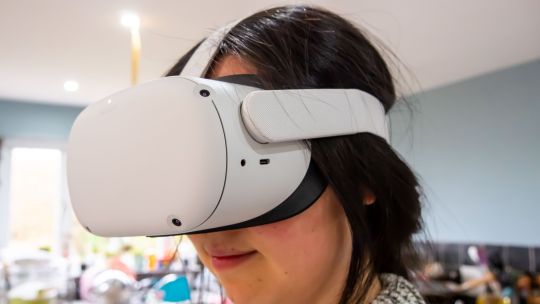
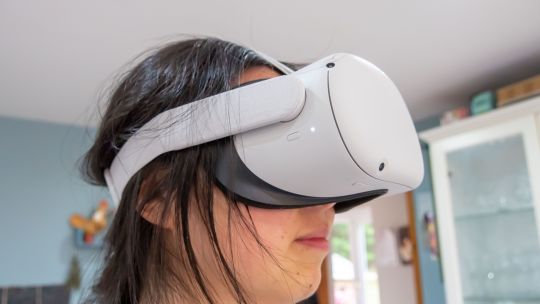
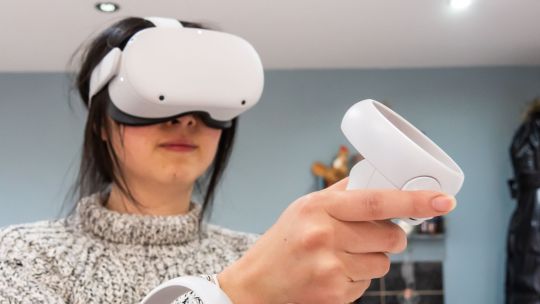

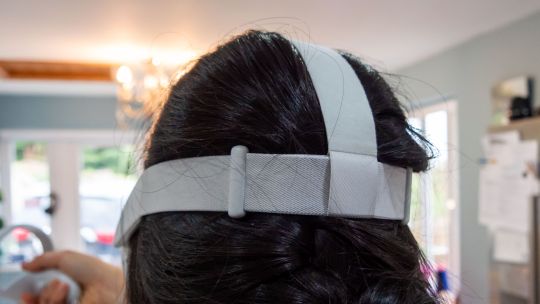
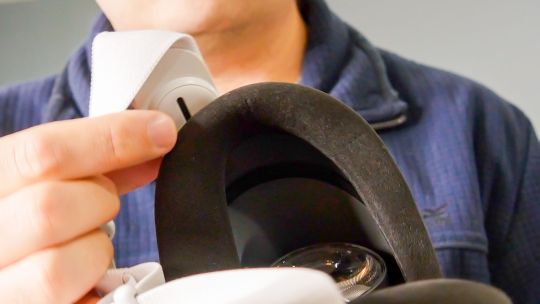



See on amazon
Not only is the Oculus Quest 2 the best standalone VR headset yet, it's also the best budget option for PC gaming thanks to the Oculus Link technology. At the incredible price point of $300, it's an essential purchase for anyone looking to get into VR. Existing Oculus Quest owners might be disappointed by the black levels, but we think the increased resolution and responsiveness is well worth the trade-off.
Specifications
Brand: Oculus (Facebook)
Resolution (per eye): 1832 x 1920px
Display Type: RGB-stripe LCD
Storage: 64 / 256 GB
Connectivity: Wi-Fi 6 and 802.11ac, Bluetooth 5.0, USB-C, 3.5mm Stereo Out
Battery Life: 2-3 Hours
Tracking Technology: Inside out cameras on the headset
Audio: Built-in speakers
Weight: 1.1 lbs
Pros
Hand-tracking is reliable, though not all software supports it yet
RGB-stripe LCD adds resolution and pixel density, eliminating any screen-door effect
Incredible value for a standalone headset, and a great buget choice for PC gaming
Cons
Audio is terrible, but easy enough to plug in your own headphones
Black levels are worse than the original Quest
Buy This Product

Oculus Quest 2 amazon
Shop
<![CDATA[ // Bottom var galleryThumbs1 = new Swiper('.gallery-thumbs-1', { spaceBetween: 10, slidesPerView: 10, freeMode: true, watchSlidesVisibility: true, watchSlidesProgress: true, centerInsufficientSlides: true, allowTouchMove: false, preventClicks: false, breakpoints: { 1024: { slidesPerView: 6, } }, }); // Top var galleryTop1 = new Swiper('.gallery-top-1', { spaceBetween: 10, allowTouchMove: false, loop: true, preventClicks: false, breakpoints: { 1024: { allowTouchMove: true, } }, navigation: { nextEl: '.swiper-button-next', prevEl: '.swiper-button-prev', }, thumbs: { swiper: galleryThumbs1 } }); ]]>
An incredible resolution, powerful mobile processor, and extensive software library make the Oculus Quest 2 the best wireless VR headset yet. And if you have the right cable and a gaming PC, it's also the best budget PC VR headset. That's quite an achievement–especially at a price point of just $300.
Read on to find out why the Oculus Quest 2 is the best mobile VR experience yet.
youtube
Why Should You Trust My Opinion?
I've been following 3D display technologies since the early 2000s, starting with NVidia's 3DVision. I backed the original Oculus Development Kit Kickstarter after reading about it from an MTBS3D forum member. From the moment it arrived, I knew it would change gaming forever, despite only a single demo being available.

I kept throwing money at VR, on the Dev Kit 2, consumer edition Rift, HTC Vive (eventually with wireless upgrade), Oculus Go, and Oculus Quest. My current headset of choice is the Valve Index, though I probably use the Quest more than anything because of its convenience.
Note the absence of the Rift S. I knew at the time it was a dead-end for Oculus, bridging the gap while they perfected Oculus Link technology. I was right, and Facebook has confirmed that the Rift hardware ends here, with all future efforts pushed to the mobile space.
We’re going to focus on standalone VR headsets moving forward. We’ll no longer pursue PC-only hardware, with sales of Rift S ending in 2021. That said, the Rift Platform isn’t going anywhere. In fact, we've seen significant growth in PC VR via Oculus Link, and the Rift Platform will continue to grow while offering high-end PC VR experiences like Lone Echo II and Medal of Honor: Above and Beyond well into the future. - Oculus.com
Quest 2 Technical Specs and Design
Aesthetically, the Quest 2 has undergone one significant change: it's now white. This is undoubtedly the result of numerous psychological studies that told Facebook that white was a more acceptable color for consumer electronics destined for use in the living room. And they're probably right, given that sales of the Oculus Quest 2 are so far outstripping the original many times over. Other than that, the shape and overall design of the Quest 2 is relatively unchanged.

It ships with a flimsy head strap that tends to fall off in vigorous use and results in a weight distribution that's uncomfortably forward-heavy on the face. While Oculus sells a replacement "Elite" strap with a ratcheting lock, it's overpriced, and early reports indicate it's poorly made and prone to snapping. You'll find a better one on AliExpress.

There are two versions of the Quest 2 available to purchase, differing only in the amount of storage space. The basic model at $300 has 64GB, while $400 will get you significantly more at 256GB. If you plan only to play games, 64GB is plenty enough. If you want to store big movies to watch offline when traveling, 256GB will likely be your best bet.
You can expect anywhere from two to three hours of use from the battery on the Oculus Quest 2. Two hours if you're playing games, three if you're watching movies. To ensure there's any battery left when you next pick it up, remember to power off the device completely by holding the power button and selecting "shutdown." Merely taking the headset off will turn the screen off, but the system will be paused and run the battery down in a day or so. The Elite Strap includes a battery which will give another two to three hours. There is no battery limitation when tethered to a PC.

A USB-C charging cable and adaptor are also included in the package, though it's not long enough to be used for Oculus Link. A glasses adaptor is provided for those who find the headset is bumping up against their own lenses, which extends the face plate about 1/4 inch further out. It's easy to fit as the faceplate is simple to remove.
Visual Quality
The screen inside the Oculus Quest is perhaps the most significant change compared to the Quest, and it's not all for the better. Running at a higher overall resolution of 1832x1920 pixels per eye, compared to 1440x1600 on the Quest, Facebook opted for a single RGB-stripe LCD panel. The RGB-stripe configuration results in pixels that are closer together, and therefore higher density. This eliminates any so-called "screen door effect" and generally gives a higher perceived resolution (on top of a higher actual and ix resolution). Combined, it results in an incredibly sharp display. The display is also now capable of running at 90Hz, though this is not enabled by default, and most games don't take advantage of it yet. If I sound like I'm glossing over this point, it's because the 75Hz refresh has never bothered me.
Unfortunately, the choice of a single panel LCD, rather than dual-panel OLEDs found in the original Quest, has two significant drawbacks.

The first is the lack of real IPD (inter-pupillary distance) adjustment. Facebook has compromised and provided three discrete physical IPD settings, which you can click into place. These should cover everyone from 58mm to 68mm, though only those with the entirely average 63mm will get the best experience, and there's no software adjustment to accompany this—it's physically moving the position of the lenses. Therefore the area of the image you're focusing on also slightly changes. Sadly I can't comment on how non-ideal it is for other IPDs, as I fall into the category of entirely average.
The other drawback of using an LCD panel is the black levels. In short, they're more dark grey than black. If you play horror games, such as Walking Dead: Saints and Sinners, or enjoy watching darker movies in your personal VR cinema, you may notice it more than others.
To be clear, these are minor complaints. Other improvements in the resolution and pixel density far outweigh any perceived issue with black levels.
Audio Quality
The audio system feels upgraded but still terrible. Sound emanates from somewhere within the headset and is piped to your ears via the plastic clips on the side. Unfortunately, I'd forgotten how bad it sounds, having replaced the head strap on my original Quest with some 3D printed adaptors and the HTC Vive Deluxe Audio Strap.

Though the sound quality is clean and gets pretty loud, with no muffled voices or distortion, it completely lacks bass. On top of that, there is no audio isolation at all. Partly, this is by design: Facebook wants you to stay somewhat connected to the outside world. But it works both ways, and the outside world can hear everything you do in VR.
Of course, you can fix the audio easily, so it's not a dealbreaker. A single 3.5mm stereo jack on the left-hand side enables you to plug in earbuds or your favorite cans. But that's some ugly wires on what is other an elegantly minimalist design.
Controllers
The controllers are also superficially unchanged other than being white now, with the same selection of capacitive buttons, a thumbstick, trigger, and grip button. This configuration means existing library software should work as is, with little required for developers to update code. A single AA battery powers each controller, with a ring of invisible tracking LEDs.

Upon closer examination, they appear to be slightly larger than the original controllers, though not noticeably so in use. I still find my hands cramping up after extended sessions. A capacitive thumb rest has been added.
Tracking, Passthrough, and Hands
Though the tracking technology also appears to be unchanged–with four cameras on the headset watching the LEDs embedded in the controller–it certainly feels smoother. The additional processing in the CPU results in less overall tracking hiccups, such that any blame for missed blocks in BeatSaber is now squarely on your shoulders.
Hand-tracking too feels distinctly smoother and more reliable. It feels like a viable way to interact with the system now, though not all software has been updated to use it.

Also greatly improved is the camera passthrough feature. A quick double-tap on the side of the headset immediately reveals your surroundings, so you can step over the cat, take a sip of coffee, or inflict a brutal tickling on your child who thinks daddy can't see anything when he's wearing his headset.
Got a PC? Plug It In with Oculus Quest Link
While the Oculus Quest 2 delivers an incredible wireless VR experience, the graphical quality will never compare to those rendered on a desktop gaming PC. But with Quest 2, you needn't choose. Just plug in the Quest 2 using a USB-C to USB-C or USB-A cable, and you can enjoy full access to the desktop Oculus software or vast Steam library. Graphics will be rendered on your PC and sent to the Oculus Quest 2, just like any other tethered PC headset. I expect you're asking yourself, "can I play Half-Life Alyx on the Oculus Quest 2?!" and the answer is a resounding yes. Valve hasn't locked its games to any particular headset, and with full SteamVR access and native controller support, everything works as expected. And it's incredible.

Oculus sells a branded fiber-optic Link cable for the best quality, though it's quite pricey at around $90. This Belkin cable is also officially compatible. If you have a USB2.0 cable (strangely, not all USB-C cables are rated for USB3.0 transfer speeds), you can still use Oculus Link, though the visual clarity will be somewhat degraded.
You probably think this is a bad experience compared to a "normal" wired headset. While it doesn't quite compare to the $1000 Index, it's certainly not what I'd call subpar. I've used a lot of tethered VR headsets and would be quite happy using just the Quest 2.
As for Quest Link latency: it's imperceivable. Even in fast-paced FPS games, or rhythm action titles like Beat Saber, I couldn't notice any latency. For comparison sake, I usually use a Valve Index tethered to my gaming PC.
Games on Oculus Quest
I tested in three games: Rec Room, Beat Saber, and Walking Dead: Saints and Sinners. The former two I have many hours of playing across platforms, so I'm intimately familiar with them. The latter I bought to compare directly the Quest 1 and 2, with fresh pair of eyes.
Overall, it was a mixed bag of results.
Beat Saber appears to be updated, and as far as I can tell, it takes full advantage of the resolution bump. The strobing lights and bright contrasts work particularly well on this type of display.
Rec Room, however, felt like legacy software. Though it's opened some additional maps for Quest 2 users to take advantage of additional graphical capabilities, the game appears to run at a lower resolution than the Quest 2 is capable of. The screen felt darker, with colors more muted than the Quest 1. I then compared to the SteamVR version of RecRoom over Oculus Link, and sure enough, it was a world of difference with bright visuals, even over a USB2 cable.

Walking Dead: Saints and Sinners is about as gloomy as a game can get, played mostly under cover of darkness, with fog effects galore. And sure enough, the black levels here were a murky dark grey at best. Swapping back and forth between Quest 1 and 2 highlights the screen differences. That said, given a choice between higher resolution or better black levels, I'd choose the higher resolution every time.

Of course, it should go without saying that these are my subjective opinions only, and your experience may vary.
The F-Word: Facebook
We can't review the Oculus Quest 2 and not mention the requisite Facebook account. While the Quest 2 has excellent hand-tracking, that's probably not the only thing it's tracking. As is written clearly on the box, this device requires a Facebook account. No ifs, no buts, no workarounds, no opt-out. And not just for social integrations (as was previously the case), but to merely activate and use your device.
If you're thinking, "that's ok, I'll just make a fake account," then think again: many users have found their fake accounts deleted and have lost access to all their Oculus purchases. Not only do you need a Facebook account to use the Quest 2, but you also need a real, active account. You'll be asked to submit a photo ID if Facebook suspects shenanigans.
Precisely what privacy implications this will hold in the future is yet to be determined. Will Facebook be able to watch everything you do in VR? It seems unlikely, though it is technically possible. For now, Facebook has stated that it'll be strongly moderating user actions within the new Horizons social VR space, currently in beta for selected users. A rolling camera (similar to a car dashcam) will record everything you do, and if another user reports you, the relevant footage will be saved and uploaded for manual review. Facebook employees will also be able to drop in on your at any point and remain invisible to observe your behavior. While this sounds terrifying to some, it may be precisely what social VR spaces need to succeed. The potential for long-term psychological harm in online social networks is somewhat limited when interactions are text-only. In VR's physical space, they're on a whole other level.

Personally, I couldn't care less. I merged my Facebook and Oculus account a long time ago. If I did have a dark alter-ego where I live out sadistic fantasies or troll feminist gamers, I probably wouldn't be doing it anywhere near the account where my mum is.
But for those of you who are entirely Facebook averse, I doubt the technological progress that the Quest 2 brings will be enough to convince you otherwise. In which case, consider yourself out of the mobile VR game because there isn't a worthwhile alternative.
Should You Upgrade From the Quest?
The original Oculus Quest felt like a mid-range smartphone unwillingly coerced into doing double duty as a VR headset. It was still the best VR experience at the time of release, and throughout its lifecycle, no other viable contender stepped up.
The Quest 2, however, flies along, doing whatever it's told with glee. While the Quest's hardware inadequacies remain unchanged (the horrendous audio and uncomfortable headset), it's understandable that some compromises had to be made to get a high-resolution wireless all-in-one VR headset down to the frankly ludicrous price point of $300. Facebook has delivered on its promise of making VR accessible for the masses, and we should praise it for that endeavor. If we need to give up a little privacy for that, then so be it. VR's ability to teleport us to anywhere we can dream of is a powerful tool for change, and I want everyone to have that opportunity.
As for whether you should upgrade? It's debatable. Personally, the resolution bump, more powerful processor, and generally more responsive UI throughout are more than worth it. I would have happily paid $500 for a "Pro" version of the Quest 2, with an OLED screen and possibly better audio, but I'm pleased with the upgrade. I'll add some padding to the controllers and replace the head strap; such is the convenience of a world with 3D printing. I'm not a massive fan of horror movies or scary games—there's enough horror in real life. I want my VR experiences to be bright and colorful. But if you know you're a stickler for black levels, you might want to hold off.
The Oculus Quest 2 isn't just the best mobile headset, with a gimmicky feature that lets you plug it into a PC. It's the best budget PC VR headset, too. While it may be a questionable upgrade for some original Quest owners, it's the best choice if you don't already have a VR headset. You will not be disappointed.
Do You Have Oculus Quest 2 Questions? We've Got Answers!
How much do Oculus Quest games cost?
Games in the Oculus Quest library cost anywhere from nothing (Rec Room, with in-app purchases for cosmetic items that you can also buy with earned currency) to $19 per month for Supernatural VR, a fitness game with licensed music. Most fall between the $5–$20 mark.
How Big Are Oculus Quest 2 Games?
If you're considering whether to buy the 64GB or 256GB Oculus Quest 2, you should know that even the biggest Quest game is around 8GB, meaning you can comfortably fit several on the 64GB model. Most games (and apps) are under 1GB. If you just plan to play games and not store large movies, 64GB is plenty enough.
How to Stream Oculus Quest to Twitch?
By default, you can stream to the Oculus app on your phone, a Chromecast 3 device, or your personal Facebook page. For anything else, like Twitch, you'll need some cables and a PC. Using a USB-C cable, the ScrCpy utility (built into SideQuest) will display the visuals, while you'll also need a stereo audio cable to capture sound. You can then pipe this through the usual desktop app like OBS and out to your platform of choice.
Can I Play Custom BeatSaber Songs on Quest 2?
Yes, but it's not a simple process. You'll need to first enable Developer Mode and install SideQuest, a third-party unofficial app store and method of adding generic APKs to your Quest. Then you'll need to install BMBF, which includes the BeatSync mod. This will give you access to custom songs from BSaber.
How Does Oculus Quest 2 Tracking Work?
The Quest 2 features four small cameras embedded in the headset. These watch your play space to figure out how your head is moving. At the same time, there is a ring of infra-red LEDs on each controller, which only the headset can see. Combined, you have full freedom of movement and motion controls in a standalone package. A virtual Guardian wall will prevent you from leaving the play area. You can either draw this using the passthrough cameras, or opt for a standing-only play area (in which you can turn around, but stay in one spot). The wide-angle cameras situated on the sides and bottom of the Quest 2 ensure ample coverage. While moving your controller around your back will force it to lose tracking, this rarely occurs in practice. The Oculus Quest 2 tracking cannot fully function in darkness: it must see your environment. If it's unable to track your surroundings, the system will revert to a 3DOF mode, whereby you can only rotate the headset and have no positional tracking. This mode is fine for watching movies in a dark environment.
Does Oculus Quest 2 Have Full Body Tracking?
No. While the Quest 2 is capable of tracking your hands (without using controllers), it's not able to track your feet or the rest of your body. Full-body tracking is only possible using third-party hardware in tethered Oculus Link mode.
Oculus Quest 2 Review: The Best Headset for Everyone posted first on grassroutespage.blogspot.com
0 notes
Text
Oculus Quest 2 Review: The Best Headset for Everyone
Oculus Quest 2
9.00 / 10
Read Reviews
Read More Reviews
Read More Reviews
Read More Reviews
Read More Reviews
Read More Reviews
Read More Reviews
Read More Reviews
Read More Reviews
Read More Reviews
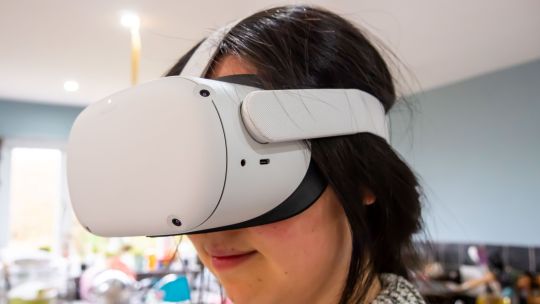
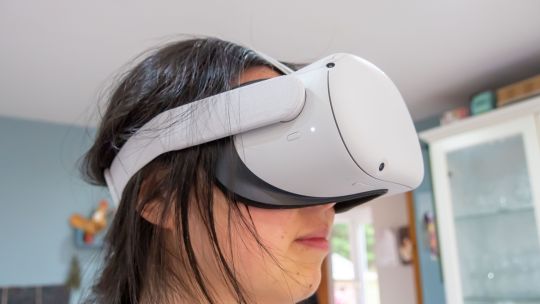
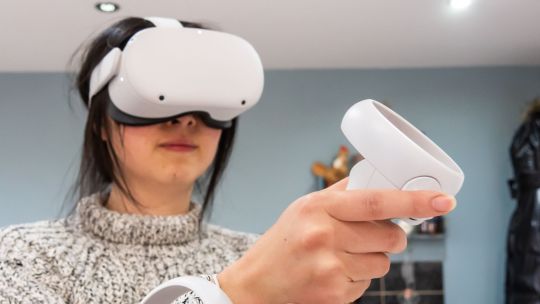
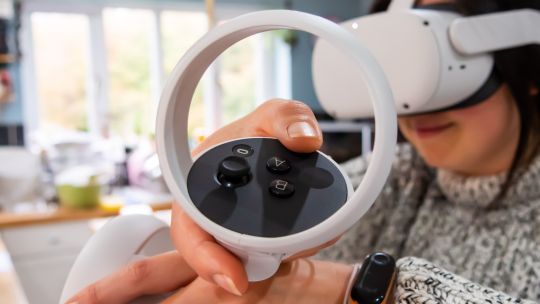
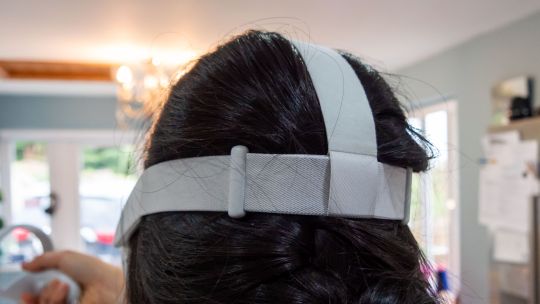
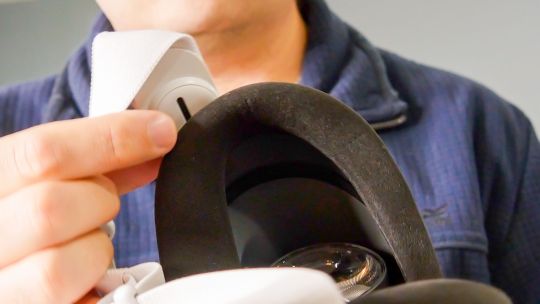
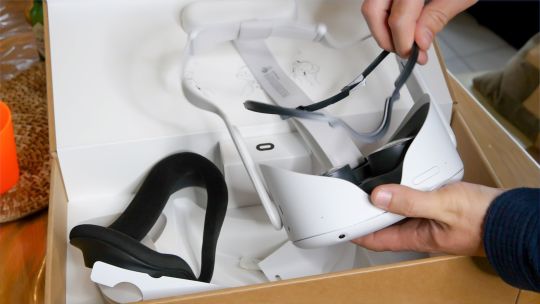
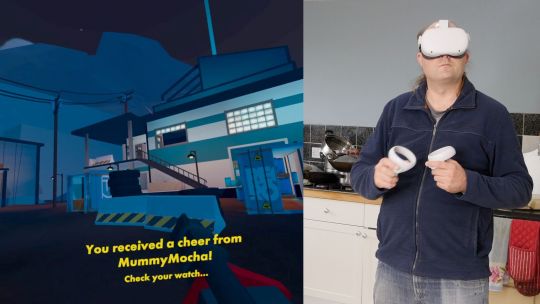
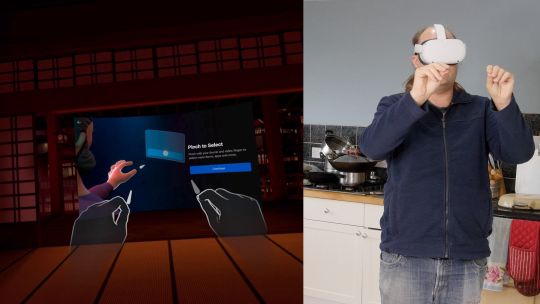
See on amazon
Not only is the Oculus Quest 2 the best standalone VR headset yet, it's also the best budget option for PC gaming thanks to the Oculus Link technology. At the incredible price point of $300, it's an essential purchase for anyone looking to get into VR. Existing Oculus Quest owners might be disappointed by the black levels, but we think the increased resolution and responsiveness is well worth the trade-off.
Specifications
Brand: Oculus (Facebook)
Resolution (per eye): 1832 x 1920px
Display Type: RGB-stripe LCD
Storage: 64 / 256 GB
Connectivity: Wi-Fi 6 and 802.11ac, Bluetooth 5.0, USB-C, 3.5mm Stereo Out
Battery Life: 2-3 Hours
Tracking Technology: Inside out cameras on the headset
Audio: Built-in speakers
Weight: 1.1 lbs
Pros
Hand-tracking is reliable, though not all software supports it yet
RGB-stripe LCD adds resolution and pixel density, eliminating any screen-door effect
Incredible value for a standalone headset, and a great buget choice for PC gaming
Cons
Audio is terrible, but easy enough to plug in your own headphones
Black levels are worse than the original Quest
Buy This Product

Oculus Quest 2 amazon
Shop
// Bottom var galleryThumbs1 = new Swiper('.gallery-thumbs-1', { spaceBetween: 10, slidesPerView: 10, freeMode: true, watchSlidesVisibility: true, watchSlidesProgress: true, centerInsufficientSlides: true, allowTouchMove: false, preventClicks: false, breakpoints: { 1024: { slidesPerView: 6, } }, }); // Top var galleryTop1 = new Swiper('.gallery-top-1', { spaceBetween: 10, allowTouchMove: false, loop: true, preventClicks: false, breakpoints: { 1024: { allowTouchMove: true, } }, navigation: { nextEl: '.swiper-button-next', prevEl: '.swiper-button-prev', }, thumbs: { swiper: galleryThumbs1 } });
An incredible resolution, powerful mobile processor, and extensive software library make the Oculus Quest 2 the best wireless VR headset yet. And if you have the right cable and a gaming PC, it's also the best budget PC VR headset. That's quite an achievement–especially at a price point of just $300.
Read on to find out why the Oculus Quest 2 is the best mobile VR experience yet.
youtube
Why Should You Trust My Opinion?
I've been following 3D display technologies since the early 2000s, starting with NVidia's 3DVision. I backed the original Oculus Development Kit Kickstarter after reading about it from an MTBS3D forum member. From the moment it arrived, I knew it would change gaming forever, despite only a single demo being available.
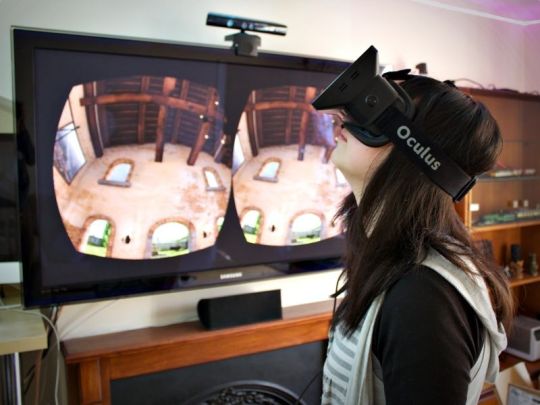
I kept throwing money at VR, on the Dev Kit 2, consumer edition Rift, HTC Vive (eventually with wireless upgrade), Oculus Go, and Oculus Quest. My current headset of choice is the Valve Index, though I probably use the Quest more than anything because of its convenience.
Note the absence of the Rift S. I knew at the time it was a dead-end for Oculus, bridging the gap while they perfected Oculus Link technology. I was right, and Facebook has confirmed that the Rift hardware ends here, with all future efforts pushed to the mobile space.
We’re going to focus on standalone VR headsets moving forward. We’ll no longer pursue PC-only hardware, with sales of Rift S ending in 2021. That said, the Rift Platform isn’t going anywhere. In fact, we've seen significant growth in PC VR via Oculus Link, and the Rift Platform will continue to grow while offering high-end PC VR experiences like Lone Echo II and Medal of Honor: Above and Beyond well into the future. - Oculus.com
Quest 2 Technical Specs and Design
Aesthetically, the Quest 2 has undergone one significant change: it's now white. This is undoubtedly the result of numerous psychological studies that told Facebook that white was a more acceptable color for consumer electronics destined for use in the living room. And they're probably right, given that sales of the Oculus Quest 2 are so far outstripping the original many times over. Other than that, the shape and overall design of the Quest 2 is relatively unchanged.

It ships with a flimsy head strap that tends to fall off in vigorous use and results in a weight distribution that's uncomfortably forward-heavy on the face. While Oculus sells a replacement "Elite" strap with a ratcheting lock, it's overpriced, and early reports indicate it's poorly made and prone to snapping. You'll find a better one on AliExpress.

There are two versions of the Quest 2 available to purchase, differing only in the amount of storage space. The basic model at $300 has 64GB, while $400 will get you significantly more at 256GB. If you plan only to play games, 64GB is plenty enough. If you want to store big movies to watch offline when traveling, 256GB will likely be your best bet.
You can expect anywhere from two to three hours of use from the battery on the Oculus Quest 2. Two hours if you're playing games, three if you're watching movies. To ensure there's any battery left when you next pick it up, remember to power off the device completely by holding the power button and selecting "shutdown." Merely taking the headset off will turn the screen off, but the system will be paused and run the battery down in a day or so. The Elite Strap includes a battery which will give another two to three hours. There is no battery limitation when tethered to a PC.

A USB-C charging cable and adaptor are also included in the package, though it's not long enough to be used for Oculus Link. A glasses adaptor is provided for those who find the headset is bumping up against their own lenses, which extends the face plate about 1/4 inch further out. It's easy to fit as the faceplate is simple to remove.
Visual Quality
The screen inside the Oculus Quest is perhaps the most significant change compared to the Quest, and it's not all for the better. Running at a higher overall resolution of 1832x1920 pixels per eye, compared to 1440x1600 on the Quest, Facebook opted for a single RGB-stripe LCD panel. The RGB-stripe configuration results in pixels that are closer together, and therefore higher density. This eliminates any so-called "screen door effect" and generally gives a higher perceived resolution (on top of a higher actual and ix resolution). Combined, it results in an incredibly sharp display. The display is also now capable of running at 90Hz, though this is not enabled by default, and most games don't take advantage of it yet. If I sound like I'm glossing over this point, it's because the 75Hz refresh has never bothered me.
Unfortunately, the choice of a single panel LCD, rather than dual-panel OLEDs found in the original Quest, has two significant drawbacks.

The first is the lack of real IPD (inter-pupillary distance) adjustment. Facebook has compromised and provided three discrete physical IPD settings, which you can click into place. These should cover everyone from 58mm to 68mm, though only those with the entirely average 63mm will get the best experience, and there's no software adjustment to accompany this—it's physically moving the position of the lenses. Therefore the area of the image you're focusing on also slightly changes. Sadly I can't comment on how non-ideal it is for other IPDs, as I fall into the category of entirely average.
The other drawback of using an LCD panel is the black levels. In short, they're more dark grey than black. If you play horror games, such as Walking Dead: Saints and Sinners, or enjoy watching darker movies in your personal VR cinema, you may notice it more than others.
To be clear, these are minor complaints. Other improvements in the resolution and pixel density far outweigh any perceived issue with black levels.
Audio Quality
The audio system feels upgraded but still terrible. Sound emanates from somewhere within the headset and is piped to your ears via the plastic clips on the side. Unfortunately, I'd forgotten how bad it sounds, having replaced the head strap on my original Quest with some 3D printed adaptors and the HTC Vive Deluxe Audio Strap.

Though the sound quality is clean and gets pretty loud, with no muffled voices or distortion, it completely lacks bass. On top of that, there is no audio isolation at all. Partly, this is by design: Facebook wants you to stay somewhat connected to the outside world. But it works both ways, and the outside world can hear everything you do in VR.
Of course, you can fix the audio easily, so it's not a dealbreaker. A single 3.5mm stereo jack on the left-hand side enables you to plug in earbuds or your favorite cans. But that's some ugly wires on what is other an elegantly minimalist design.
Controllers
The controllers are also superficially unchanged other than being white now, with the same selection of capacitive buttons, a thumbstick, trigger, and grip button. This configuration means existing library software should work as is, with little required for developers to update code. A single AA battery powers each controller, with a ring of invisible tracking LEDs.

Upon closer examination, they appear to be slightly larger than the original controllers, though not noticeably so in use. I still find my hands cramping up after extended sessions. A capacitive thumb rest has been added.
Tracking, Passthrough, and Hands
Though the tracking technology also appears to be unchanged–with four cameras on the headset watching the LEDs embedded in the controller–it certainly feels smoother. The additional processing in the CPU results in less overall tracking hiccups, such that any blame for missed blocks in BeatSaber is now squarely on your shoulders.
Hand-tracking too feels distinctly smoother and more reliable. It feels like a viable way to interact with the system now, though not all software has been updated to use it.

Also greatly improved is the camera passthrough feature. A quick double-tap on the side of the headset immediately reveals your surroundings, so you can step over the cat, take a sip of coffee, or inflict a brutal tickling on your child who thinks daddy can't see anything when he's wearing his headset.
Got a PC? Plug It In with Oculus Quest Link
While the Oculus Quest 2 delivers an incredible wireless VR experience, the graphical quality will never compare to those rendered on a desktop gaming PC. But with Quest 2, you needn't choose. Just plug in the Quest 2 using a USB-C to USB-C or USB-A cable, and you can enjoy full access to the desktop Oculus software or vast Steam library. Graphics will be rendered on your PC and sent to the Oculus Quest 2, just like any other tethered PC headset. I expect you're asking yourself, "can I play Half-Life Alyx on the Oculus Quest 2?!" and the answer is a resounding yes. Valve hasn't locked its games to any particular headset, and with full SteamVR access and native controller support, everything works as expected. And it's incredible.

Oculus sells a branded fiber-optic Link cable for the best quality, though it's quite pricey at around $90. This Belkin cable is also officially compatible. If you have a USB2.0 cable (strangely, not all USB-C cables are rated for USB3.0 transfer speeds), you can still use Oculus Link, though the visual clarity will be somewhat degraded.
You probably think this is a bad experience compared to a "normal" wired headset. While it doesn't quite compare to the $1000 Index, it's certainly not what I'd call subpar. I've used a lot of tethered VR headsets and would be quite happy using just the Quest 2.
As for Quest Link latency: it's imperceivable. Even in fast-paced FPS games, or rhythm action titles like Beat Saber, I couldn't notice any latency. For comparison sake, I usually use a Valve Index tethered to my gaming PC.
Games on Oculus Quest
I tested in three games: Rec Room, Beat Saber, and Walking Dead: Saints and Sinners. The former two I have many hours of playing across platforms, so I'm intimately familiar with them. The latter I bought to compare directly the Quest 1 and 2, with fresh pair of eyes.
Overall, it was a mixed bag of results.
Beat Saber appears to be updated, and as far as I can tell, it takes full advantage of the resolution bump. The strobing lights and bright contrasts work particularly well on this type of display.
Rec Room, however, felt like legacy software. Though it's opened some additional maps for Quest 2 users to take advantage of additional graphical capabilities, the game appears to run at a lower resolution than the Quest 2 is capable of. The screen felt darker, with colors more muted than the Quest 1. I then compared to the SteamVR version of RecRoom over Oculus Link, and sure enough, it was a world of difference with bright visuals, even over a USB2 cable.

Walking Dead: Saints and Sinners is about as gloomy as a game can get, played mostly under cover of darkness, with fog effects galore. And sure enough, the black levels here were a murky dark grey at best. Swapping back and forth between Quest 1 and 2 highlights the screen differences. That said, given a choice between higher resolution or better black levels, I'd choose the higher resolution every time.

Of course, it should go without saying that these are my subjective opinions only, and your experience may vary.
The F-Word: Facebook
We can't review the Oculus Quest 2 and not mention the requisite Facebook account. While the Quest 2 has excellent hand-tracking, that's probably not the only thing it's tracking. As is written clearly on the box, this device requires a Facebook account. No ifs, no buts, no workarounds, no opt-out. And not just for social integrations (as was previously the case), but to merely activate and use your device.
If you're thinking, "that's ok, I'll just make a fake account," then think again: many users have found their fake accounts deleted and have lost access to all their Oculus purchases. Not only do you need a Facebook account to use the Quest 2, but you also need a real, active account. You'll be asked to submit a photo ID if Facebook suspects shenanigans.
Precisely what privacy implications this will hold in the future is yet to be determined. Will Facebook be able to watch everything you do in VR? It seems unlikely, though it is technically possible. For now, Facebook has stated that it'll be strongly moderating user actions within the new Horizons social VR space, currently in beta for selected users. A rolling camera (similar to a car dashcam) will record everything you do, and if another user reports you, the relevant footage will be saved and uploaded for manual review. Facebook employees will also be able to drop in on your at any point and remain invisible to observe your behavior. While this sounds terrifying to some, it may be precisely what social VR spaces need to succeed. The potential for long-term psychological harm in online social networks is somewhat limited when interactions are text-only. In VR's physical space, they're on a whole other level.

Personally, I couldn't care less. I merged my Facebook and Oculus account a long time ago. If I did have a dark alter-ego where I live out sadistic fantasies or troll feminist gamers, I probably wouldn't be doing it anywhere near the account where my mum is.
But for those of you who are entirely Facebook averse, I doubt the technological progress that the Quest 2 brings will be enough to convince you otherwise. In which case, consider yourself out of the mobile VR game because there isn't a worthwhile alternative.
Should You Upgrade From the Quest?
The original Oculus Quest felt like a mid-range smartphone unwillingly coerced into doing double duty as a VR headset. It was still the best VR experience at the time of release, and throughout its lifecycle, no other viable contender stepped up.
The Quest 2, however, flies along, doing whatever it's told with glee. While the Quest's hardware inadequacies remain unchanged (the horrendous audio and uncomfortable headset), it's understandable that some compromises had to be made to get a high-resolution wireless all-in-one VR headset down to the frankly ludicrous price point of $300. Facebook has delivered on its promise of making VR accessible for the masses, and we should praise it for that endeavor. If we need to give up a little privacy for that, then so be it. VR's ability to teleport us to anywhere we can dream of is a powerful tool for change, and I want everyone to have that opportunity.
As for whether you should upgrade? It's debatable. Personally, the resolution bump, more powerful processor, and generally more responsive UI throughout are more than worth it. I would have happily paid $500 for a "Pro" version of the Quest 2, with an OLED screen and possibly better audio, but I'm pleased with the upgrade. I'll add some padding to the controllers and replace the head strap; such is the convenience of a world with 3D printing. I'm not a massive fan of horror movies or scary games—there's enough horror in real life. I want my VR experiences to be bright and colorful. But if you know you're a stickler for black levels, you might want to hold off.
The Oculus Quest 2 isn't just the best mobile headset, with a gimmicky feature that lets you plug it into a PC. It's the best budget PC VR headset, too. While it may be a questionable upgrade for some original Quest owners, it's the best choice if you don't already have a VR headset. You will not be disappointed.
Do You Have Oculus Quest 2 Questions? We've Got Answers!
How much do Oculus Quest games cost?
Games in the Oculus Quest library cost anywhere from nothing (Rec Room, with in-app purchases for cosmetic items that you can also buy with earned currency) to $19 per month for Supernatural VR, a fitness game with licensed music. Most fall between the $5–$20 mark.
How Big Are Oculus Quest 2 Games?
If you're considering whether to buy the 64GB or 256GB Oculus Quest 2, you should know that even the biggest Quest game is around 8GB, meaning you can comfortably fit several on the 64GB model. Most games (and apps) are under 1GB. If you just plan to play games and not store large movies, 64GB is plenty enough.
How to Stream Oculus Quest to Twitch?
By default, you can stream to the Oculus app on your phone, a Chromecast 3 device, or your personal Facebook page. For anything else, like Twitch, you'll need some cables and a PC. Using a USB-C cable, the ScrCpy utility (built into SideQuest) will display the visuals, while you'll also need a stereo audio cable to capture sound. You can then pipe this through the usual desktop app like OBS and out to your platform of choice.
Can I Play Custom BeatSaber Songs on Quest 2?
Yes, but it's not a simple process. You'll need to first enable Developer Mode and install SideQuest, a third-party unofficial app store and method of adding generic APKs to your Quest. Then you'll need to install BMBF, which includes the BeatSync mod. This will give you access to custom songs from BSaber.
How Does Oculus Quest 2 Tracking Work?
The Quest 2 features four small cameras embedded in the headset. These watch your play space to figure out how your head is moving. At the same time, there is a ring of infra-red LEDs on each controller, which only the headset can see. Combined, you have full freedom of movement and motion controls in a standalone package. A virtual Guardian wall will prevent you from leaving the play area. You can either draw this using the passthrough cameras, or opt for a standing-only play area (in which you can turn around, but stay in one spot). The wide-angle cameras situated on the sides and bottom of the Quest 2 ensure ample coverage. While moving your controller around your back will force it to lose tracking, this rarely occurs in practice. The Oculus Quest 2 tracking cannot fully function in darkness: it must see your environment. If it's unable to track your surroundings, the system will revert to a 3DOF mode, whereby you can only rotate the headset and have no positional tracking. This mode is fine for watching movies in a dark environment.
Does Oculus Quest 2 Have Full Body Tracking?
No. While the Quest 2 is capable of tracking your hands (without using controllers), it's not able to track your feet or the rest of your body. Full-body tracking is only possible using third-party hardware in tethered Oculus Link mode.
Oculus Quest 2 Review: The Best Headset for Everyone published first on http://droneseco.tumblr.com/
0 notes
Text
Price: [price_with_discount] (as of [price_update_date] - Details) [ad_1] The Bluerigger USB 3.0 Active Extension Cable supports 480-Mbps transmission speed of the latest USB 3.0 standard. This lets you take complete advantage of your peripherals and devices. USB 3.0 Active Extension/ Repeater cable and its uses - This cable lets you extend USB connections by 10 meters (32 feet) between your computer and USB devices thereby giving you the added ability to move away from your desktop while using your VoIP phone or mouse - You can connect USB devices such as printers, keyboards, storage devices, Display Link USB displays, mice and most miscellaneous USB devices from across the room with this cable - The cable features a Male A connector on one end that plugs into your computer and a Female A connector on the other that connects to the cable you need extended - Note: Do check your device manuals to make sure this is the connector you need - Note: Not to be used for charging USB devices like smartphone and music players Key Features - Premium Shielding & Built in Amplification Chipset: The Cable features premium shielding and a built in amplification chipset that provides protection against interference from electromagnetic and radio-frequency signals thus enabling higher performance. - Gold-Plated Connectors: The repeater cable features gold-plated connectors that resist corrosion for signal purity. Compatibility - Windows 7, Vista, XP, 2000, ME, 98SE - Mac OS - Linux - No drivers required on any OS - Devices with precise timing requirements (such as USB cameras) not recommended Technical Specifications: - Connector Type: USB Type A Male, USB Type A Female - Cable Length: 10 meter / 32 feet - Transfer Rate: 480 Mbps USB 3.0 ACTIVE EXTENSION CABLE: Easy way to extend your USB connection to the computer (Mac/PC) for use with VR Headsets, Game Consoles, USB Flash Drive, Hard Drive, Card Reader, Mouse, Keyboard, Printer, Scanner, Camera and other USB peripherals UNIVERSAL COMPATIBILITY: The USB male to female extension cable is compatible with all USB A devices, plug and play, no drivers required on any OS including Windows, Mac OS, Linux, and Chrome OS. Backwards compatible with USB 2.0 and USB 1.1 standard devices. Compatible with Oculus Rift, HTC VIVE, PlayStation VR, Valve Index, Microsoft HoloLens VR headsets EXQUISITE WORKMANSHIP: Constructed with multiple layers of shielding to minimize interference. Engineered with corrosion-resistant nickel-plated connectors for optimal signal clarity. Premium aluminum alloy casing for better heat dissipation 5 GBPS DATA TRANSFER: Our USB 3.0 extension cord provides a high speed data transfer rate up to 5 Gbps, which is 10 times faster than USB 2.0 (480 Mbps). This allows you transfer HD movies, music or files in seconds, when equipped with USB 3.0 port LIFETIME WARRANTY: BlueRigger cables are backed by a Lifetime Warranty and US-based customer support [ad_2]
0 notes
Video
youtube
Alxum USB 3.0 Extension Cable offers an easy and inexpensive way to easily connect your USB device from across the room to the computer up to 32 Feet/10Meters: https://www.alxum.com/products/oculus-rift-extension-cable
Anybody need this extension cable for SecurityCamera? 🤔How to extand longer distance? Enjoy within reach! Make your Camera printer, any usb device more flexible in other room~ 🙆WEme 10M USB 3.0 Extension Cable 👌Support up to 32 FT between your computer and devices over long distances transfer. 👉Cable: https://www.alxum.com/products/oculus-rift-extension-cable #Webcam #SecurityCamera #Printer #Scanner #Microphone #WiFiAntenna #Telescope #VR #Xbox #USBDevices #Alxum
What Devices You Could Extend: # USB Extension Cable Compatibility: Compatible USB devices: Mouse, Keyboard, Printer, Scanner, Camera, Webcam, USB Flash Drive, Hard Drive, Gamepad, Xbox 360 Kinect, Speaker, WiFi Receiver, USB Hubs, etc. # Compatible VR devices: PlayStation VR, Oculus Quest, Oculus Quest 2, Oculus Rift Sensor, HTC Vive, Valve index,etc. # Compatible System: Plug and Play on mainstream operating systems including Windows, Vista, Mac OS, Linux, Chrome OS, etc.
Easily to extend your webcam, printer, oculus vr devices with Two Signal Boosters that ensure no signal attenuation for 10 meters/32ft length.
View Blog: How Active USB 3.0 Extension Cable Help You Out https://www.alxum.com/blogs/news/how-active-usb-3-0-extension-cable-help-you-out Why Extension Cable is Needed for a Oculus Rift? [How to Extend Your Webcam & USB Devices (Alxum 10M Extension Cable)] https://www.alxum.com/blogs/news/why-extension-cable-is-needed-for-a-oculus-rift
What kind of extension cable you need: 15M Alxum USB 3.0 Extension Cable (NEW!!!): https://www.alxum.com/products/active-usb-extension-cable 10M Alxum USB 3.0 Extension Cable: https://www.alxum.com/products/oculus-rift-extension-cable 10M WEme USB C Extension Cable: https://www.alxum.com/products/usb-c-extension-cable-for-oculus-vr-10m-32ft 5M WEme USB C Extension Cable: https://www.alxum.com/products/usb-c-extension-cable-for-oculus-vr-5m-16-4ft 10M WEme USB 3.0 Extension Cable: https://www.alxum.com/products/usb-3-0-extension-cable-for-oculus-rift-10m-32ft 5M WEme USB 3.0 Extension Cable: https://www.alxum.com/products/usb-extension-cable 5M WEme USB3.0 Extension Cable: https://www.alxum.com/products/usb-3-0-extension-cable-with-signal-amplifier-5m-16ft
0 notes
Text
BEST OCULUS QUEST LINK CABLE SOLUTIONS -
Oculus Quest, one of the best VR headsets for movies, games and immersive experience and its coolest feature is that it allows a high-resolution connection with a Computer, especially if you have a gaming graphics card onboard. Unfortunately, finding a cable solution is not easy a walk in the park, as the cable for Oculus Link strictly has to meet a standard prerequisite. The official website, doesn’t provide a brief detail for an Oculus Link Cable other than it must be a USB 3.0 cable. The official Oculus Link cable is expensive at $80 and often not available in every region. However, Oculus do recommend third-party cable from Anker, but you don’t have to necessarily follow this as there are more widely available options at cheaper prices, given the same performance. Additional tip, you’ll want to acquire a cable that has angled connector which makes routing the cable to the back of your Oculus headset easier and keep it from wear and tears. Additionally, try to avoid USB-C to USB-A adapters/dongles as this might create incompatibility or point of failure. Moreover, the cable should directly be connected to USB 3.0 port on the computer or laptop (don’t use USB 2.0 connector on the PC). If your graphics card has a USB C port, then using it directly would be optimum.
BEST USB-C TO USB-C OCULUS LINK CABLE
Value Pick
#1 PartyLink USB Type C Cable 16ft(5m)
This cable from party link would work absolutely fine, as opposed to official Oculus Link cable but the USB port on your device should be gen 1 at least and be able to support graphics card, otherwise this is not a right choice for you. Buy Now: https://www.amazon.com/PartyLink-Type-C-Compatible-Transfer-Charging/dp/B082TTKCZY/ BEST VALUE #2 CableCreation Active USB Extension Cable (Long 16.4 FT), USB 3.0 Extender Male to Female Cord with Signal Booster Compatible Oculus Rift VR, Oculus Quest/Link, Xbox one, etc. 5 Meters
This Extension cable will work flawlessly, but remember it’s just an extension. You will need a USB 3.0 Type C to Type A cable, any good quality would suffice. Thus this extension is to be used in the combination of both. The USB A port on this extension will connect with PC/Laptop while USB C to A from oculus rift will connect with the female port on this extension. If you happen to have a 4FT USB C to A Cable then total extension would be 20FT, which is just amazing. Ton of space room for any movements desired.
Buy Now: https://www.amazon.com/CableCreation-Extension-Extender-Booster-Compatible/dp/B0179MXKU8/
Favorite Pick
#3 Orzero Total 8M / 26Ft USB Stable Data Cable Compatible for Oculus Quest Link Steam VR, Extension Cable(5M) with Relay Amplifier Chip
This is an active USB 3.0 cable which consists of a relay amplifier that allows you to go up till 26FT. This is only great for a VR Gaming hall but also for Cameras, Printers and other USB 3.0 devices. Buy Now: https://www.amazon.com/Orzero-Stable-Compatible-Extension-Amplifier/dp/B083KC67CD/
0 notes
Text
Top 10 Best VR Extension Cable In 2019 Review
VR remains a term that is currently used to portray 3D PC-oriented environments. It helps to replace the actual reality that occurs in your daily lifestyle. Virtual reality extension cables also play a big rule to make this technology comes out strong. Are you looking for the best virtual reality extension cable to produces a great result? Explore the top 10 best VR extension cable in 2019 review to get more information on making the right choice.
# Preview Product Price 1


USB 3.0 Extender, WEme USB Extension Cable with Aluminum Alloy Housing, Type A Male to Female Cord for Oculus Rift, VR Headset, HTC Vive, Xbox, USB Peripheral Devices, 5 Meters 16.4 Feets
$14.99
Check Now!
2


USB 3.0 Extension Cable 15 Feet,Ruaeoda SuperSpeed USB 3.0 Type A Male to Female Extension USB Cable for Webcam, Printer, Playstation, Xbox, USB Flash Drive, Card Reader, Hard Drive, Keyboard, Camera
Check on Amazon
Check Now!
3


AmazonBasics High-Speed Male to Female HDMI Extension Cable – 6 Feet
$6.99
Check Now!
4


USB Extension Cable, JSAUX Type A Male to A Female 3.0 Extender Cord 6.6ft 5Gbps Data Transfer for USB Flash Drive Disk, Keyboard, Mouse, Playstation, Xbox, Oculus VR, Card Reader, Printer(Black)
Check on Amazon
Check Now!
5


UGREEN USB Extension Cable USB 3.0 Extender Cord Type A Male to Female Data Transfer Lead for Playstation, Xbox, Oculus VR, USB Flash Drive, Card Reader, Hard Drive, Keyboard, Printer, Camera (6ft)
$6.79
Check Now!
6


WAYTCG HDMI Cable 15 ft – High Speed HDMI Cord 2.0 with Gold Plated Corrosion Resistant Connectors – Supports Ethernet 4K 2160p 1080p 3D and Audio Return Channel(ARC) – 15 Feet
$8.98
Check Now!
7


Twisted Veins HDMI Cable 15 ft, 2-Pack, Premium HDMI Cord Type High Speed with Ethernet, Supports HDMI 2.0b 4K 60hz HDR on Most Devices and May Only Support 4K 30hz on Some Devices
$13.96
Check Now!
8


BAM 3 Pack High Speed 4K HDMI Cables (6 Feet)
Check on Amazon
Check Now!
9


BlueRigger 4K HDMI Cable (15 Feet, Black,4K 60Hz, High Speed, Nylon Braided)
$11.99
Check Now!
#10. WEme SuperSpeed VR Extension Cable


This product is compatible with a plethora of devices. Connecting other devices with this VR extension cable at a comfortable distance is easy and simple. It does not make you experience signal degradation, but smooth performance.
Pros:
The cable is durable and strong. It comes with aluminum housing for proper protection
The transmission signal is properly stabilized with the help of the gold-plated connector.
It comes with an upgraded amplification chipset to bolsters smooth signal transmission
Cons:
It may malfunction easily. The product can quickly burn your device
#9. Ruaeoda SuperSpeed VR Extension Cable


Just like other VR extension cables, Ruaeoda SuperSpeed can be connected to a gamut of the device. This can be found in the likes of mice, hard drives, USB hubs, keyboards, PC and just to mention a few.
Pros:
It is faster in delivering transmission
The product makes use of less power
It helps to charge your device faster and quicker
Cons:
The product can sometimes fail to deliver as expected
#8. AmazonBasics Extension Cable


The AmazonBasics combines video and audio in a single comfortable. It will help buyers to connect to several devices such as HD, UHD, Roku, HDMI and much more.
Pros:
The product has a special feature that helps to get rid of background noise
There both interference and triple shield for maxing protection
The transfer rates of the product are amazing
Cons:
It sometimes experiences poor transmission of signals
#7. JSAUX VR Extension Cable


If you are looking for a VR extension cable that extends your device to a comfortable geographical location, then JSAUX a try. It has the capability to lower the unplugged and plugged time frame.
Pros:
It has universal compatibility feature
The transmission of this product is at high speed
It provides you with a stable transmission effect
Cons:
It can malfunction under high pressure
#6. UGREEN VR Extension Cable


If you want to boost your connectivity strength to other devices, UGREEN virtual reality extension cable is the real deal.
Pros:
The product is durable and flexible
It has a super performance next to none
Data transfer is great for this product
Cons:
There is every possibility for the product to develop noise
#5. RCstyle DJI Spark Coiled Spring Extension Micro USB Cable Cord For DJI Goggles VR Glasses


If you are finding the best VR Extension for DJI Product this is the best option for you to pick, Utilize for Linking the DJI Spark remote Control Using the DJI Google VR glasses. Mirco USB cable utilized for linking the Google with the DJI SparkPremium high performance with goldplated straps on both ends for the best conductivity and signal integrity. Length stretch: Ordinarily extended to 150CM Plug and play, simple to the use and signal transmitting equilibrium.
#4. WAYTCG VR Extension Cable


WAYTCG comes with gold connectors. This will help for better sound quality and image
Pros:
It is compatible with several other devices
The resolution strength and performance remains a great
Cons:
May experience some unraveling of strange actions
#3. Twisted Vein VR Extension Cable


HDMI devices will always work effectively with this product. Transferring signals remain easy and achievable with the Twisted Vein cable.
Pros :
It is easy to use
It can last for a long time
Cons:
It may not be comfortable with some devices
#2. BAM Three Pack Extension Cable


One thing you will get with BAM Three pack VR extension cable is total comfort and compatibility. It also comes with the interference-resistance feature.
Pros:
It is cheap for the price
A traveler will enjoy this product with total satisfaction
Cons:
Signals may be problematic sometimes
#1. BlueRigger VR Extension Cable


The viewing experience of BlueRigger extension cable is beyond anticipation. The amazing features of this product make it different from other VR extension cables.
Pros:
This VR extension cable is rugged, strong and durable
It can help to transfer data easily and quickly
Cons:
Slightly expensive
Conclusion:
With the comprehensive information in this content, selecting the best VR extension cable will no longer be a problem. You can take advantage of these products today and order for one.
0 notes
Photo






The My corner of nerdiness Workspace
Here are some of the products that make this workspace an Amazing Workspace:
I was really proud of myself because I managed to get a single bundle of cables from the racing rig to the computer. Also, on the rig itself, cables are virtually invisible.
Most (if not all) of my racing rig I've had for years now. The pedals, wheel & H-shifter are no longer manufactured. But it's still serving me well and 6 years ago this was a top of the line setup!
The solution was obvious, just move everything downstairs. I've been living alone for a while now, so there was nobody to tell me I can't have my grown-up toys in the middle of the house, but I was still doubting if it's the right choice.
Frex FFB Wheel & Sequential Shifter
The racing setup was in my attic. I played non-racing games on it from time to time, but it wasn't ideal. It was in a hot, tiny room and my old computer was extremely noisy (R9 290 video card, for people who know it).
other small bits and pieces not worth mentioning
Asus VG248QE monitor, with basic IKEA wall mount
My old computer was far from silent. It was closer to washing machine noise levels, to be honest. I kept the CPU, MB & a few other important bits and rebuilt in with a silent video card and a really silent case. Because my racing rig sticks out so much, I wanted everything else to be as inconspicuous as possible, hence my choice for case, peripherals, floating desk etc.
Fractal Define Mini C case (upgraded with Noctua fans, really silent)
IKEA MILLBERGET chair
Enter /r/battlestations. I've been a long-time lurker of this sub and I've had so much inspiration from so many great setups. I wanted something minimalistic (as minimalistic as you can get with a racing rig in the living room!). I wanted something that looks cool, that complements the rest of my house. I wanted a floating desk, I wanted to see as little wires as possible and I wanted it to be silent.
SST H-Shifter
Computer, just for reference. Out of sight and out of mind.
Full setup, in a corner of the living room that used to be just sad and empty. I considered for a long time what to fill it with, maybe a plant, maybe a reading corner or perhaps a gaming setup...
Oculus Rift
CST pedals
I'm a casual gamer, but I still wanted a more comfortable setup. I considered building a second smaller computer and putting it in the empty corner of the living room, but that seemed like such a waste, having two gaming computers on two different floors of my house.
Racing rig. Red is my favourite color (can you tell?). I'm trying to keep everything as low-key as possible, but couldn't help myself with a few red accents.
CoolerMaster MasterMouse S
Steelseries Qck mousepad
Minimalist desktop. I debated a long time if I should get a wireless mouse and keyboard, but I've always wanted a mechanical keyboard. So I went for wired in the end. It's not ideal, with how the cables show, but the keyboard is REALLY nice!
IKEA LINNMON table top
I'm really happy with how everything turned out. There's always room for improvement, but I have a huge smile on my face when I come home at night and sit down at my battle station. That's what matters in the end, I guess.
CoolerMaster MasterKeys S keyboard
Specs, from left to right:
Cable management. I needed longer cables if I wanted to hide everything under the desk. And for some things (like the Rift) getting extensions is difficult and slightly expensive. This was good enough for me, cables are almost invisible when the chair is in place.
i5 4670K GeForce GTX 1080
Obutto oZone Cockpit
1 note
·
View note
Text
My First Oculus Rift VR Machine Build and how I Extended Cable Length by 30ft
After months of research and debating on weather or not I wanted to spend the money on not just an Oculus Rift but a machine that would be capable of handling VR, I came across an ad that essentially made that choice for me so much easier. Recently, Oculus announced a summer sale in which you can purchase the Oculus Rift headset along with the touch controllers all for $399.00. So, what comes with this bundle? Here's what you get:
Oculus Headset
A set of touch controllers
2 Sensors
Wireless X-Box Controller (batteries and Bluetooth dongle included)
Note that not all of the deals out there may include the X-Box controller. Mine did, however.
Oculus Remote
Many retailers will throw in a game or two.
Mine came with Eve Valkyrie, which I had zero interest in and just sold on eBay for $20.
Overall, this was a great deal.......until it came time for the PC build. I wanted something really interesting but since I am not a major gamer, I didn't need anything really outrageous. I don't play WoW, I don't do Call of Duty, Battlefield, or whatever the hottest and latest thing is. So, I could get away with a 1070 graphics card without any issues. So, off to Newegg I went and began my build, which goes a little something like this:
Thermaltake Core V21 Black Extreme MicroATX Cube Chassis
MSI B250M Bazooka OPT Boost LGA 1151 Intel B250 HDMI SATA 6Gb/s USB 3.1 Micro ATX Intel Motherboard with 16 GB Intel Optane Memory included and RGB LED's
MSI GeForce GTX 1070 DirectX 12 Gaming X 8GB 256-Bit GDDR5 PCIe SLI ready Graphics card
Intel Core i5-7600K Kaby Lake Quad Core 3.8 GHz Processor
Thermaltake Toughpower Grand RGB 650W Smart Zero Fan SLI/CrossFire Ready Continuous Power ATX 12V Plus Gold Certified Full Modular Power Supply
Samsung 850 EVO M.2 2280 1TB Sata III 3-D Vertical SSD
G.Skill Ripjaws V Series 16GB (2x8GB) DDR4 2400 RAM
Putting in an order for another set of these today
Gigabyte Model GC-WB867D-I Bluetooth 4.0/Wi-Fi Expansion Card
EVGA CLC 120 Liquid/Water CPU Cooler with 120mm Radiator, RGB LED, and EVGA Flow Control Software
This will be upgraded soon to something much more visually appealing. I am so not finished with this project. Further in the article I will discuss my future plans.
Windows 10 Pro
Overall, I am pleased with the build and everything works extremely well. The PC is quite fast and with the M.2 SSD, it's no wonder it's lightning fast. I have ZERO lag playing any games on the Oculus, Steam, and Origin. I've even linked it to play games on the X-Box One that sits in my daughter's room and still experience zero lag while playing Tekken 7.
As you can see, there is plenty of space on the bottom for more mods, which I intend to do. I would like a custom liquid cooling kit. Since none of the drive bays are being used, I could essentially go with a kit that utilizes the drive bays as the resorvoir/pump. I'm leaning towards something like this:
Being in the IT/Network Engineering field, cable management is essential, even at home. I like things to look neat and aesthetically pleasing. With that, baseboards were removed, wires were tucked in, Keystone wall plates and connectors were ordered, and extension cables were ordered. Here is where we ran into a bit of a problem with the Oculus Rift. The Oculus headset uses both a UBS and HDMI connection. However, if you try to extend past 6 feet with any basic cable, you will never get the headset to work. After a little research, we found that the Oculus does NOT like passive cables. In order to extend your headset past the 12 ft that is standard with your headset, you need to have ACTIVE HDMI cables. Active cables have built in chips that allow for longer runs and help push the signals the signals to run farther than your standard passive cables. I completed my setup like this:
Active HDMI cable from HDMI on video card to a Keystone on the wall
Active HDMI from that Keystone through the wall to another Keystone below my 60" TV
Oculus Headset plugs into the HDMI jack on the wall under the TV.
From the 60" TV, we ran a regular HDMI cable
For USB, we ran SuperSpeed USB 3.0 cables from the PC to the Keystone then another Superspeed USB 3.0 through the wall to the Keystone under the TV for the 2 sensors and headset USB.
I did the same for the USB cables in order to make everything look neat and not have wires and equipment constantly in the way.
So, for those looking to take advantage of the 6 week summer Oculus deal and need some ideas, I hope this article is able to help. I know many users have had a hard time with extending the length of their headset past the 12 feet and have tried many different ways unsuccessfully. I can assure you that this is this setup works 100% and that the HDMI cables make all of the difference.
If you have any questions, comments, suggestions, or just want to chat, please feel free to comment or send me an email.
2 notes
·
View notes
Text
VR in a few words
Got myself an Oculus Rift. Didn’t know the S was about to come out, so derp on me, I guess. I at least got it El Cheapo.
Installation for the Oculus App is fucking pants. C drive is mandatory, Windows Update can apparently suck a dick. Facebook wants to know how many goons I shoot in Robo Recall. Nope.
Setup works fine, with everyone and their mother screaming “ROOM-SCALE VR, REEE!” at the top of their lungs. What am I, made out of USB 3.0 ports? Give it a few months and a few paychecks and I might invest in a PCI-E USB 3.0 internal hub. Emphasis on might. This thing hogs up all my ports, but it’s not an immediate concern. Having a third sensor wouldn’t change much, plus the extension cables would need to be active, and not just extra lengths of copper in nice-looking rubber sleeves.
I am not turning my living space into more of a mess of wires, not unless I win the Time Lottery and can Linus Tech Tips my way to a seamless setup, with sensors hanging from the ceiling.
That said, Robo Recall is ridiculous fun. I’ve spent two evenings John Wicking my way through memelord robots wearing low-tops. It’s insane and it’s perfect. The 130$ VR Essentials bundle from Steam also caught my eye. We’ll see.
Someone needs to integrate a cooling solution with headsets, however. I look like that picture of a bleary-eyed and nauseated Jeff Gertzmann popping out of his HTC Vive like it’s the morning after the worst bender in recorded history.

0 notes
Photo

New red and black mesh for your Oculus Extension Cables!!! 🤘🎸🤩 Made with the highest quality materials, these breakout cables are sure make your Rift ROCK!!! . #BREAKOUTCABLE #RIFTEXTENSION #vraccessories #provrgear #immersion #virtualreality #vrswagger (at Clearwater, Florida) https://www.instagram.com/p/BsoAkrrHsE0/?utm_source=ig_tumblr_share&igshid=mja1ep8hzb5h
0 notes